check engine light Mercury Villager 1999 Owner's Manuals
[x] Cancel search | Manufacturer: MERCURY, Model Year: 1999, Model line: Villager, Model: Mercury Villager 1999Pages: 264, PDF Size: 2.19 MB
Page 9 of 264

Service engine soon
Your vehicle is equipped with a
computer that monitors the engine's
emission control system. This
system is commonly known as the
On Board Diagnostics System (OBD
II). The OBD II system protects the
environment by ensuring that your vehicle continues to meet
government emission standards. The OBD II system also assists the
service technician in properly servicing your vehicle.
TheService Engine Soonindicator light illuminates when the ignition is
first turned to the ON position to check the bulb. If it comes on after the
engine is started, one of the engine's emission control systems may be
malfunctioning. The light may illuminate without a driveability concern
being noted. The vehicle will usually be drivable and will not require
towing.
What you should do if the Service Engine Soon light illuminates
Light turns on solid:
This means that the OBD II system has detected a malfunction.
Temporary malfunctions may cause yourService Engine Soonlight to
illuminate. Examples are:
1. The vehicle has run out of fuel. (The engine may misfire or run
poorly.)
2. Poor fuel quality or water in the fuel.
3. The fuel cap may not have been properly installed and securely
tightened.
These temporary malfunctions can be corrected by filling the fuel tank
with good quality fuel and/or properly installing and securely tightening
the gas cap. After three driving cycles without these or any other
temporary malfunctions present, theService Engine Soonlight should
turn off. (A driving cycle consists of a cold engine startup followed by
mixed city/highway driving.) No additional vehicle service is required.
If theService Engine Soonlight remains on, have your vehicle serviced
at the first available opportunity.
SERVICE
ENGINE
SOON
Instrumentation
9
Page 157 of 264
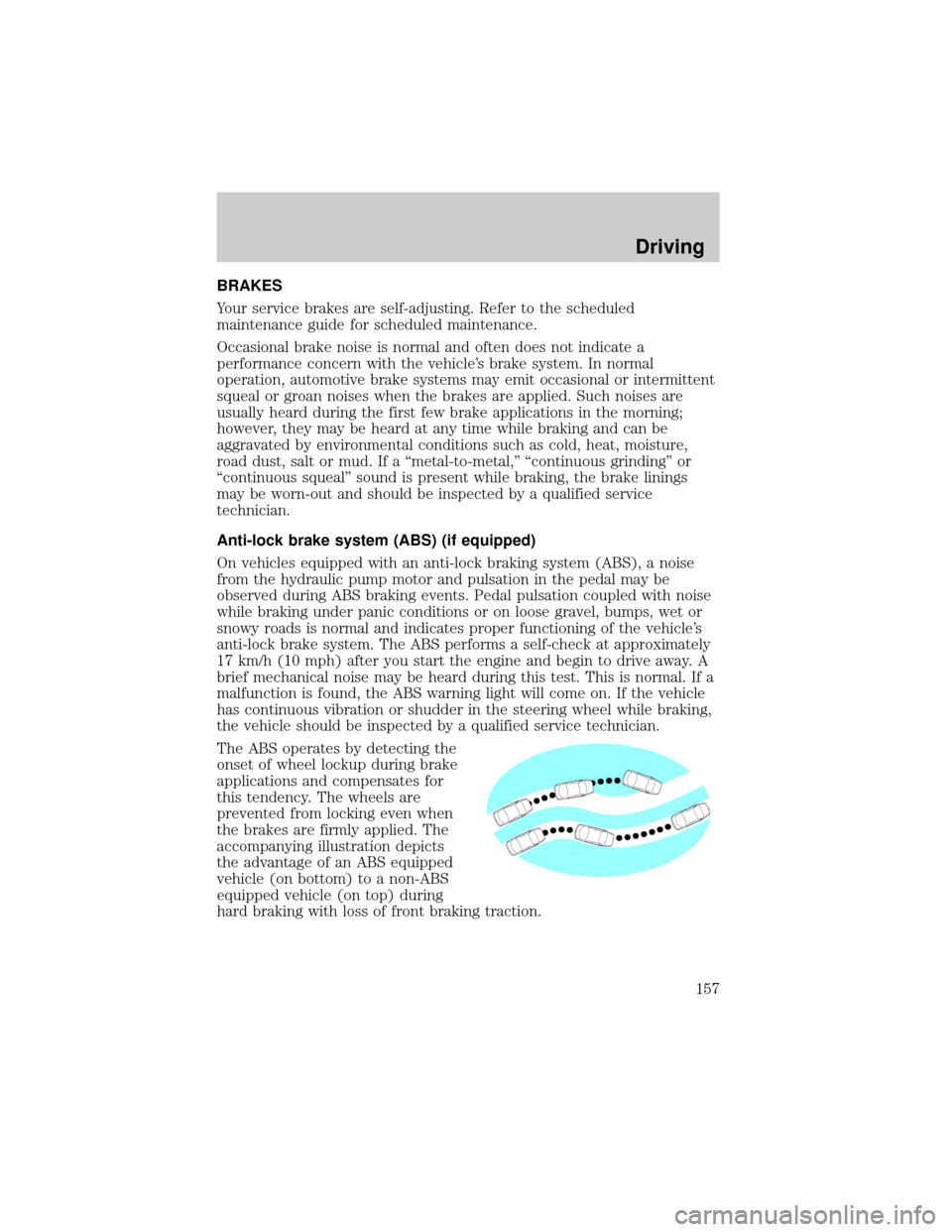
BRAKES
Your service brakes are self-adjusting. Refer to the scheduled
maintenance guide for scheduled maintenance.
Occasional brake noise is normal and often does not indicate a
performance concern with the vehicle's brake system. In normal
operation, automotive brake systems may emit occasional or intermittent
squeal or groan noises when the brakes are applied. Such noises are
usually heard during the first few brake applications in the morning;
however, they may be heard at any time while braking and can be
aggravated by environmental conditions such as cold, heat, moisture,
road dust, salt or mud. If a ªmetal-to-metal,º ªcontinuous grindingº or
ªcontinuous squealº sound is present while braking, the brake linings
may be worn-out and should be inspected by a qualified service
technician.
Anti-lock brake system (ABS) (if equipped)
On vehicles equipped with an anti-lock braking system (ABS), a noise
from the hydraulic pump motor and pulsation in the pedal may be
observed during ABS braking events. Pedal pulsation coupled with noise
while braking under panic conditions or on loose gravel, bumps, wet or
snowy roads is normal and indicates proper functioning of the vehicle's
anti-lock brake system. The ABS performs a self-check at approximately
17 km/h (10 mph) after you start the engine and begin to drive away. A
brief mechanical noise may be heard during this test. This is normal. If a
malfunction is found, the ABS warning light will come on. If the vehicle
has continuous vibration or shudder in the steering wheel while braking,
the vehicle should be inspected by a qualified service technician.
The ABS operates by detecting the
onset of wheel lockup during brake
applications and compensates for
this tendency. The wheels are
prevented from locking even when
the brakes are firmly applied. The
accompanying illustration depicts
the advantage of an ABS equipped
vehicle (on bottom) to a non-ABS
equipped vehicle (on top) during
hard braking with loss of front braking traction.
Driving
157
Page 191 of 264
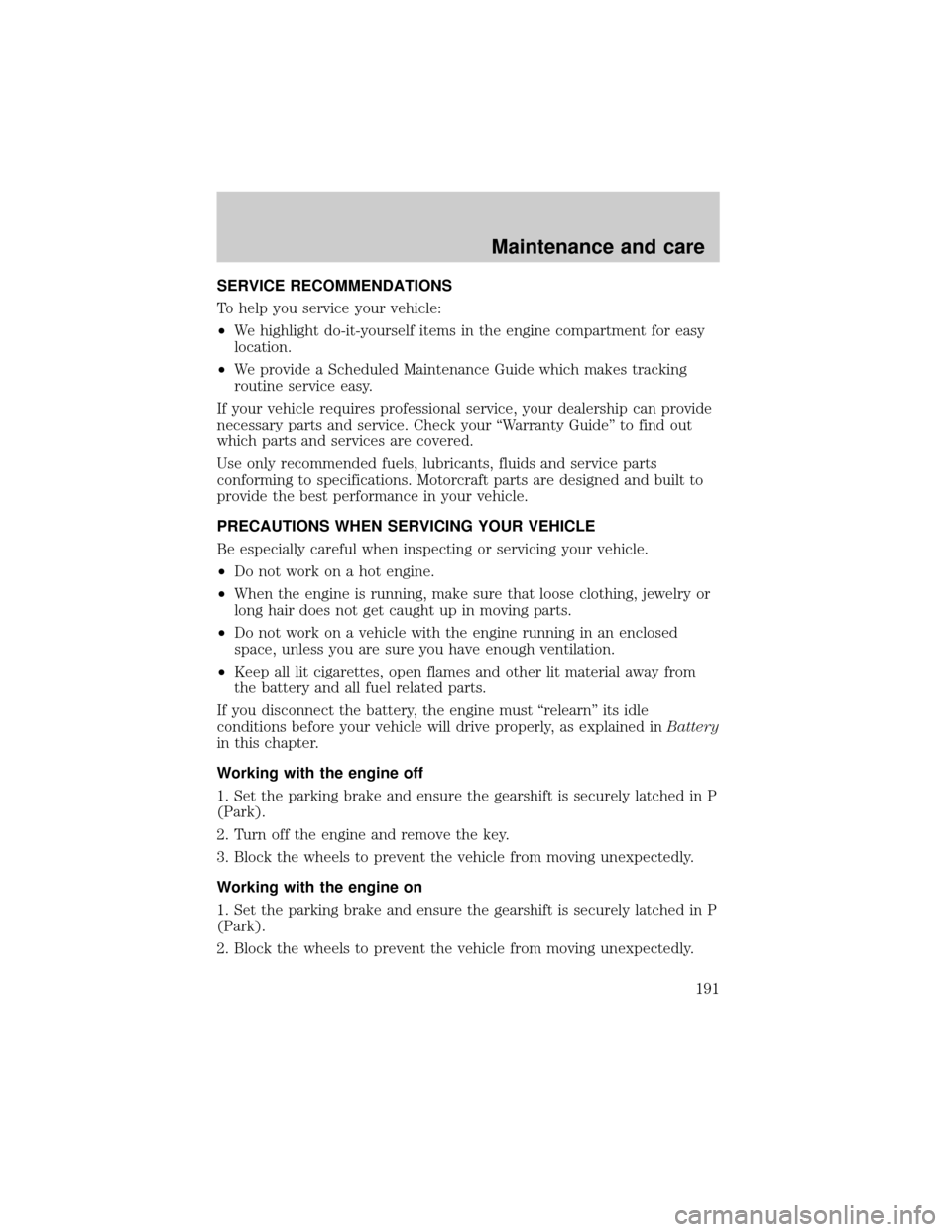
SERVICE RECOMMENDATIONS
To help you service your vehicle:
²We highlight do-it-yourself items in the engine compartment for easy
location.
²We provide a Scheduled Maintenance Guide which makes tracking
routine service easy.
If your vehicle requires professional service, your dealership can provide
necessary parts and service. Check your ªWarranty Guideº to find out
which parts and services are covered.
Use only recommended fuels, lubricants, fluids and service parts
conforming to specifications. Motorcraft parts are designed and built to
provide the best performance in your vehicle.
PRECAUTIONS WHEN SERVICING YOUR VEHICLE
Be especially careful when inspecting or servicing your vehicle.
²Do not work on a hot engine.
²When the engine is running, make sure that loose clothing, jewelry or
long hair does not get caught up in moving parts.
²Do not work on a vehicle with the engine running in an enclosed
space, unless you are sure you have enough ventilation.
²Keep all lit cigarettes, open flames and other lit material away from
the battery and all fuel related parts.
If you disconnect the battery, the engine must ªrelearnº its idle
conditions before your vehicle will drive properly, as explained inBattery
in this chapter.
Working with the engine off
1. Set the parking brake and ensure the gearshift is securely latched in P
(Park).
2. Turn off the engine and remove the key.
3. Block the wheels to prevent the vehicle from moving unexpectedly.
Working with the engine on
1. Set the parking brake and ensure the gearshift is securely latched in P
(Park).
2. Block the wheels to prevent the vehicle from moving unexpectedly.
Maintenance and care
191
Page 198 of 264
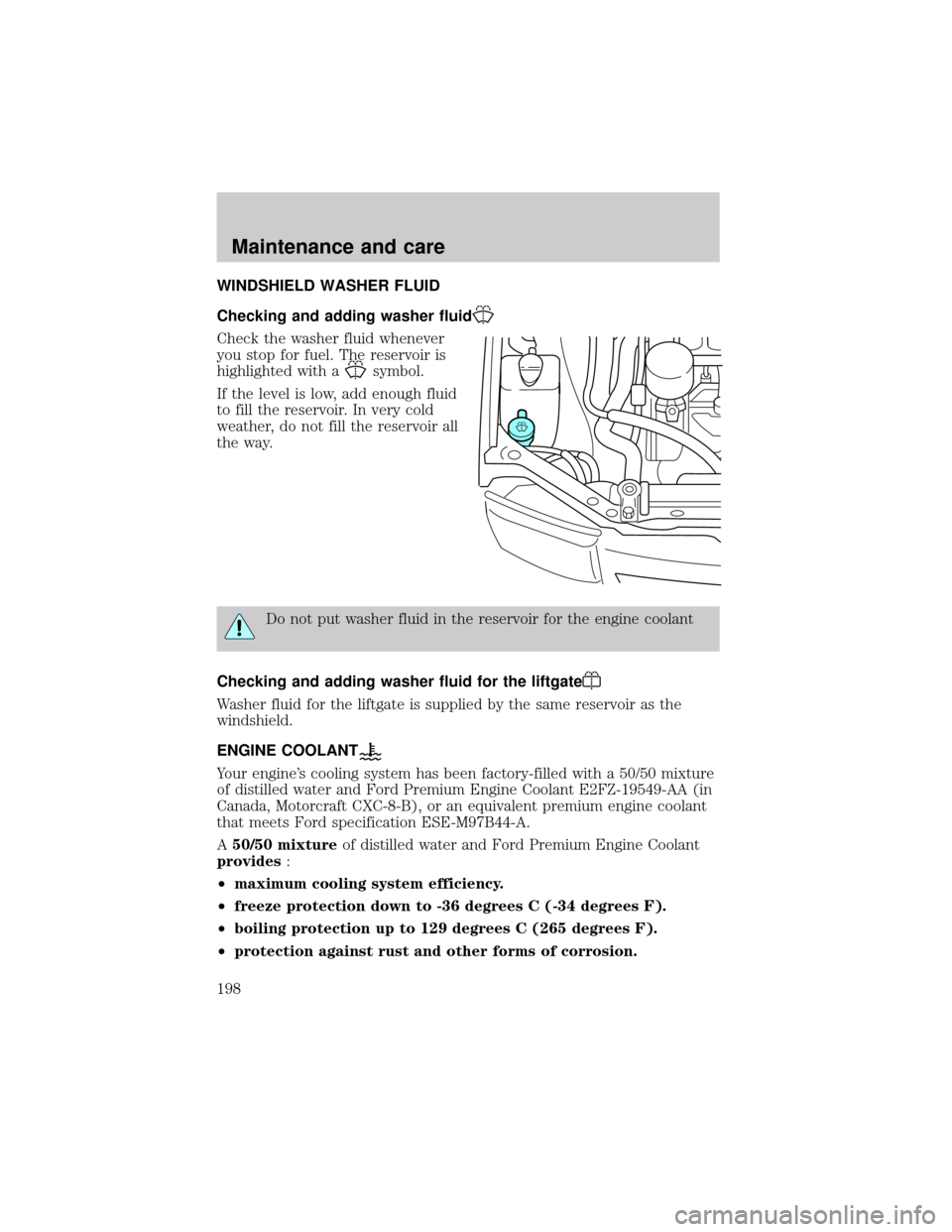
WINDSHIELD WASHER FLUID
Checking and adding washer fluid
Check the washer fluid whenever
you stop for fuel. The reservoir is
highlighted with a
symbol.
If the level is low, add enough fluid
to fill the reservoir. In very cold
weather, do not fill the reservoir all
the way.
Do not put washer fluid in the reservoir for the engine coolant
Checking and adding washer fluid for the liftgate
Washer fluid for the liftgate is supplied by the same reservoir as the
windshield.
ENGINE COOLANT
Your engine's cooling system has been factory-filled with a 50/50 mixture
of distilled water and Ford Premium Engine Coolant E2FZ-19549-AA (in
Canada, Motorcraft CXC-8-B), or an equivalent premium engine coolant
that meets Ford specification ESE-M97B44-A.
A50/50 mixtureof distilled water and Ford Premium Engine Coolant
provides:
²maximum cooling system efficiency.
²freeze protection down to -36 degrees C (-34 degrees F).
²boiling protection up to 129 degrees C (265 degrees F).
²protection against rust and other forms of corrosion.
Maintenance and care
198
Page 224 of 264
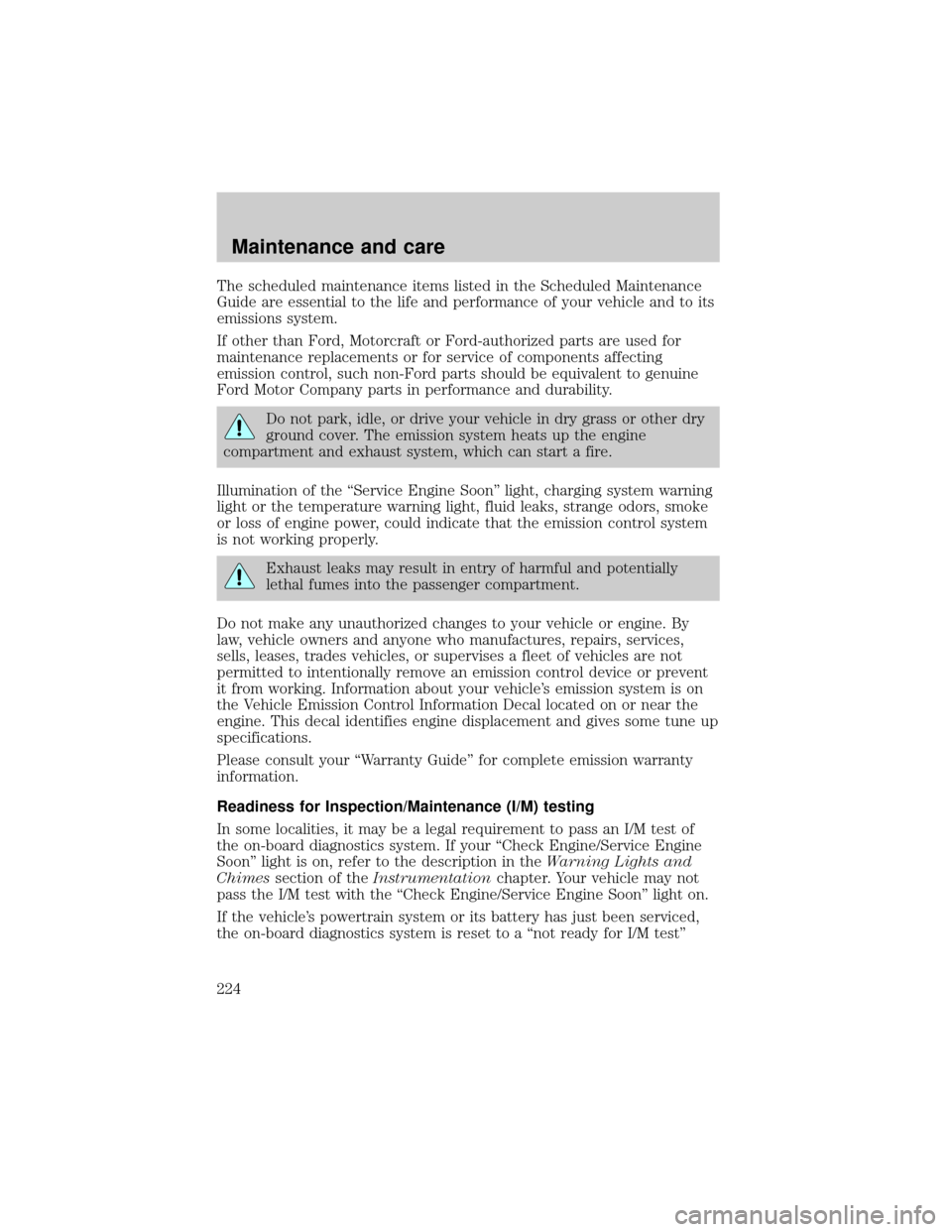
The scheduled maintenance items listed in the Scheduled Maintenance
Guide are essential to the life and performance of your vehicle and to its
emissions system.
If other than Ford, Motorcraft or Ford-authorized parts are used for
maintenance replacements or for service of components affecting
emission control, such non-Ford parts should be equivalent to genuine
Ford Motor Company parts in performance and durability.
Do not park, idle, or drive your vehicle in dry grass or other dry
ground cover. The emission system heats up the engine
compartment and exhaust system, which can start a fire.
Illumination of the ªService Engine Soonº light, charging system warning
light or the temperature warning light, fluid leaks, strange odors, smoke
or loss of engine power, could indicate that the emission control system
is not working properly.
Exhaust leaks may result in entry of harmful and potentially
lethal fumes into the passenger compartment.
Do not make any unauthorized changes to your vehicle or engine. By
law, vehicle owners and anyone who manufactures, repairs, services,
sells, leases, trades vehicles, or supervises a fleet of vehicles are not
permitted to intentionally remove an emission control device or prevent
it from working. Information about your vehicle's emission system is on
the Vehicle Emission Control Information Decal located on or near the
engine. This decal identifies engine displacement and gives some tune up
specifications.
Please consult your ªWarranty Guideº for complete emission warranty
information.
Readiness for Inspection/Maintenance (I/M) testing
In some localities, it may be a legal requirement to pass an I/M test of
the on-board diagnostics system. If your ªCheck Engine/Service Engine
Soonº light is on, refer to the description in theWarning Lights and
Chimessection of theInstrumentationchapter. Your vehicle may not
pass the I/M test with the ªCheck Engine/Service Engine Soonº light on.
If the vehicle's powertrain system or its battery has just been serviced,
the on-board diagnostics system is reset to a ªnot ready for I/M testº
Maintenance and care
224
Page 225 of 264
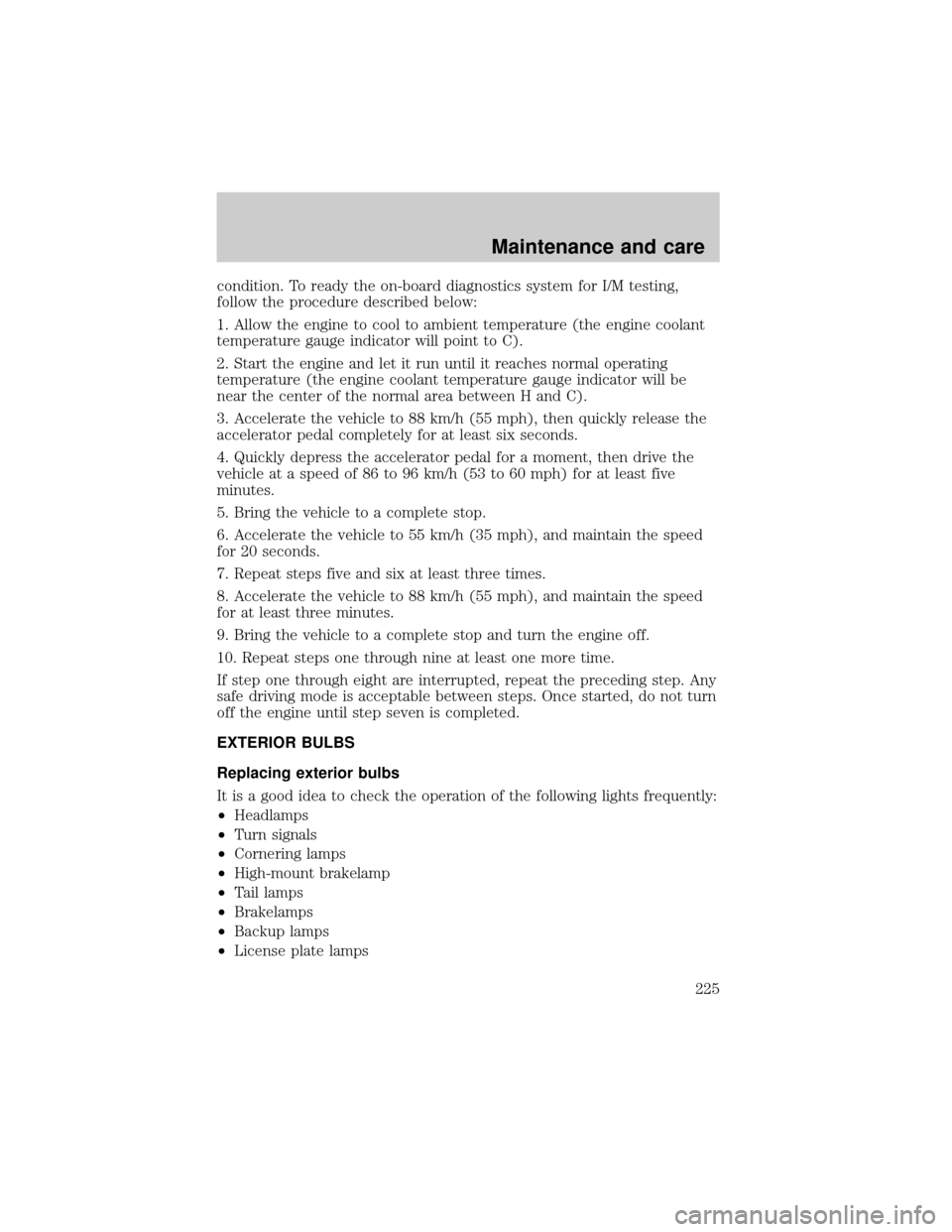
condition. To ready the on-board diagnostics system for I/M testing,
follow the procedure described below:
1. Allow the engine to cool to ambient temperature (the engine coolant
temperature gauge indicator will point to C).
2. Start the engine and let it run until it reaches normal operating
temperature (the engine coolant temperature gauge indicator will be
near the center of the normal area between H and C).
3. Accelerate the vehicle to 88 km/h (55 mph), then quickly release the
accelerator pedal completely for at least six seconds.
4. Quickly depress the accelerator pedal for a moment, then drive the
vehicle at a speed of 86 to 96 km/h (53 to 60 mph) for at least five
minutes.
5. Bring the vehicle to a complete stop.
6. Accelerate the vehicle to 55 km/h (35 mph), and maintain the speed
for 20 seconds.
7. Repeat steps five and six at least three times.
8. Accelerate the vehicle to 88 km/h (55 mph), and maintain the speed
for at least three minutes.
9. Bring the vehicle to a complete stop and turn the engine off.
10. Repeat steps one through nine at least one more time.
If step one through eight are interrupted, repeat the preceding step. Any
safe driving mode is acceptable between steps. Once started, do not turn
off the engine until step seven is completed.
EXTERIOR BULBS
Replacing exterior bulbs
It is a good idea to check the operation of the following lights frequently:
²Headlamps
²Turn signals
²Cornering lamps
²High-mount brakelamp
²Tail lamps
²Brakelamps
²Backup lamps
²License plate lamps
Maintenance and care
225
Page 255 of 264

Accessory delay ..........................90
Air bag supplemental restraint
system ........................................131
and child safety seats ............133
description ..............................131
disposal ....................................135
driver air bag ..........................133
indicator light ......................6,135
operation .................................133
passenger air bag ...................133
Air cleaner filter .........204,205,235
Air conditioning ..........................21
automatic temperature
control system ..........................29
Air filter, cabin ..........................207
Anti-theft system ......................104
arming the system ..................104
disarming a triggered
system .....................................105
disarming an untriggered
system .....................................105
Automatic transaxle .................160
driving with .............................161
fluid, refill capacities ..............235
fluid, specification ..................237
Battery .......................................205
acid, treating emergencies .....205
charging system warning
light ..............................................6
jumping a disabled battery ....185
maintenance-free ....................205
replacement, specifications ...235
servicing ..................................205
Brakes ........................................157
anti-lock ............................157,158
anti-lock brake system (ABS)
warning light ........................8,158
brake warning light ....................7
fluid, checking and adding ....197
fluid, refill capacities ..............235
fluid, specifications ..........236,237
lubricant specifications ...236,237parking ....................................158
shift interlock ..........................160
Break-in period .............................2
Capacities for refilling fluids ....235
Cargo cover ...............................108
Cargo net ............................107,108
CD changer .................................76
Child safety restraints ..............136
child safety belts ....................136
child safety seats ....................137
Child safety seats ......................137
attaching with tether straps ..141
built-in child seat ...................137
in front seat ............................138
in rear seat .......................138,141
tether anchorage hardware ...143
Cleaning your vehicle ...............230
built-in child seat .....148,151,234
engine compartment ..............232
exterior .............................231,233
exterior lamps .........................233
instrument panel ....................233
interior ..............................233,234
mirrors .....................................234
plastic parts ............................232
safety belts ..............................234
washing ....................................230
waxing .....................................231
wheels ......................................231
windows ..................................234
wiper blades ............................233
Clock ..................................47,59,71
Console
overhead ...............................97,98
Controls ........................93,94,95,96
power seat ...............................111
steering column ........................85
Coolant ...............................198,201
checking and adding ..............199
refill capacities .................201,235
specifications ...................236,237
Customer Assistance ................241
Index
255
Page 256 of 264

Ford accessories for your
vehicle .....................................248
Ford Extended Service
Plan ..........................................242
Getting assistance outside the
U.S. and Canada .....................248
Getting roadside
assistance ................................241
Getting the service you
need .........................................243
Ordering additional owner's
literature .................................253
The Dispute Settlement
Board .......................................245
Defrost
rear window ..............................39
Dipstick
engine oil .................................194
Doors
door ajar warning .......................7
Driving under special
conditions
through water .........................164
Emergencies, roadside
jump-starting ..........................185
Emission control system ..........223
Engine .................................237,238
check engine/service engine
soon light ....................................9
coolant .....................................198
idle speed control ...................205
lubrication
specifications ...................236,237
refill capacities ........................235
service points ..........................193
starting after a collision .........171
Engine block heater .................155
Engine oil ..................................194
checking and adding .......194,195
dipstick ....................................194
filter, specifications .........196,235
recommendations ...................196refill capacities .................194,235
specifications .....194,196,236,237
Exhaust fumes ..........................155
Floor mats ...................................92
Fluid capacities .........................235
Fuel ............................................215
calculating fuel economy .......220
cap ...........................................217
capacity ...................................235
choosing the right fuel ...........218
comparisons with EPA fuel
economy estimates .................223
detergent in fuel .....................219
filling your vehicle with
fuel .............................215,217,220
filter, specifications .........220,235
fuel pump shut-off switch .....171
gauge .........................................13
improving fuel economy ........220
low fuel warning light ................8
octane rating .............219,237,238
quality ......................................219
running out of fuel .................219
safety information relating to
automotive fuels .....................215
Fuses ...................................172,173
Garage door opener ..........93,94,98
Gas cap (see Fuel cap) ............217
Gas mileage (see Fuel
economy) ...................................220
Gauges .........................................11
engine coolant temperature
gauge .........................................14
fuel gauge ..................................13
odometer ...................................13
speedometer .............................12
trip odometer ............................13
GAWR (Gross Axle Weight
Rating) .......................................165
definition .................................165
driving with a heavy load ......165
location ....................................165
Index
256